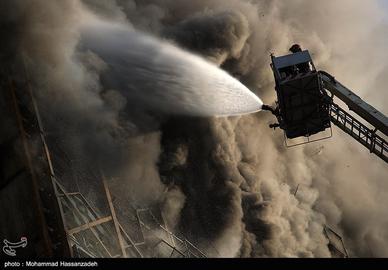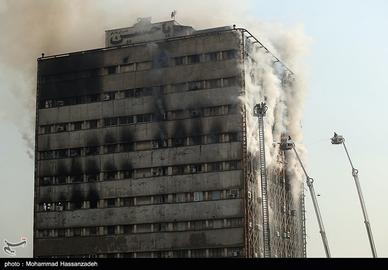Saeed Mahmoudi-Nasab, Citizen journalist, Tehran
Morteza Rezaei, former commander of the Tehran Police and a member of the City Council, arrived at the scene of the Plasco fire just a few hours after the 17-floor building had collapsed, killing dozens of firefighters and other victims.
A firefighter, who had been clearing the debris when Rezaei arrived, stopped his work and vented his frustration, rage and fatigue, built up since early in the morning, at the city official.
“What are you looking at?” he shouted at Rezaei. “Give money so we can buy equipment. This one is done for. It was finished several years ago.”
The tense muscles in his neck reflected his increasing rage.
“When we need money, why don’t you give it?” he shouted. “Why do we have to send letter after letter?” Rezaei just looked on — bewildered and silent, as if he too was exhausted and had nothing to offer but silence. His silence will surely be remembered by reporters and others on the scene.
The young firefighter was only saying what has been said repeatedly for many years: that firefighting equipment in Tehran and across Iran is in disrepair, old and obsolete.
The role of outdated equipment in the Plasco Building disaster has received little coverage so far. But observers have drawn early conclusions just by looking at the pictures. A water-hose latter was too short for a high-rise, reaching only the seventh floor; there were no firefighting helicopters, which could have helped to control the fire; there were no camera-equipped robots to work alongside rescue dogs in finding survivors; Tehran’s shortage of fire hydrants limited access to water; and, most importantly, old equipment such as loaders, mechanical shovels, electric drills, firefighting trucks and individual firefighters’ equipment were obsolete and unfit for purpose.
One firefighter said yesterday that their hydraulic cutter broke while they were using it – forcing them to abandon the scene. This is just one example of why the young fireman had turned his fury on Morteza Rezaei.
Useless Equipment: 80 Percent
Another City Council member told IranWire that more than 80 percent of the Tehran Fire Department’s equipment are unfit for fighting fires or helping people affected by a fire.
In 2013, a dressmaking workshop in Tehran’s Republic Avenue caught fire; when the fire was out of control, and there was still no help at hand, two female workers threw themselves from the building and died. That incident led to widespread demands for overhauling Tehran’s firefighting services.
Masoumeh Abad, head of the City Council’s Committee for Safety and Crisis Management, said that the issue is money.
“When the Republic Avenue incident happened and the City Council learned that it was caused by a lack of equipment, knowhow and manpower, they submitted a high-priority plan to the council. But now, two years later, nothing has been done because of insufficient funds, although it has been discussed several times by the council,” Abad said.
“Even if we have the right equipment, we do not have the raw material for them,” a trained volunteer firefighter told IranWire. “For example, the content of fire extinguishers must be replaced regularly and the firefighting foam needs chemicals to make it last. Some time ago there was an international exhibition of firefighting equipment in Tehran. But we could not even produce firefighting foam.”
Some of the equipment, like extinguisher capsules and firetrucks, are imported from Germany and the United States. Supplies for them must come from the same manufacturers. “Even if we knew how to produce the ingredients, it would be of no use,” he says.
The volunteer firefighter said that the trouble does not stop with equipment – it also goes to organization and personnel management.
“No accurate numbers have been announced,” he complained. “They say that there are probably still 20 firefighters under the wreckage. Tehran’s Fire Department says that it has five operational districts with 100 fire stations and 16 rescue stations to get to fires in the shortest amount of time. But why don’t they know how many firefighters have been dispatched? Besides the fact that their numbers are lies, do they have enough manpower to send if something else happens in another place in Tehran? Those who went [to the Plasco Building] to fight the fire were the best and the most skilled firefighters. Now who is going to take their place?”
Economic sanctions over the past decade have also taken their toll on Iran’s firefighting capability. The issue was first raised after the Republic Avenue fire. But on January 25, 2014, Vahid Momtaheni, representative of the German firefighting-truck manufacturer Magirus GmbH, denied this.
“Firefighting equipment is not something that would be affected by sanctions,” he told the website Khabar Online. “Whenever we said we needed something, our German suppliers immediately sent an expert and supplied the parts.”
300 Fires A Day
With its outdated equipment, Tehran’s Fire Department must deal with a daily average of 300 large or small fires in the city.
“After the fire at Republic Avenue, the City Council authorized many measures to provide the fire department with modern equipment and helicopters,” Mohsen Sarkhou, another member of the City Council, told ILNA news agency yesterday.
“We have warned repeatedly that the fire department is not adequately equipped to fight fire in tall buildings. Unfortunately, up to now, Tehran’s municipal government has taken no serious steps in implementing these measures,” Sarkhou added.
A few months ago, the Fire Department submitted a report to Tehran’s mayor, Mohammad Bagher Ghalibaf, informing him that to upgrade its equipment would cost 551 billion tomans, or $170 million. “At this moment we have 141 fire trucks, of which 56 have been retired or broken down,” said that report. “84 of the trucks are in working order.”
A member of the City Council also told Iranian media that 365 is the “optimum” number of fire truck Tehran needs to maintain an effective defense against fire.
In 2015, after a fire at the 13-floor Aluminum Building in Tehran, the Interior Ministry and the Tehran municipal government conducted a joint investigation, finding that “there is a lack of clear procedures for maintaining and repairing firefighting equipment.” The report specifically referred to the lack of tall ladders, a weakness on full display at the Plasco Building disaster.
Not surprisingly, the Fire Department spokesman believes that these criticisms are rumors spread on social networks and satellite TV channels. “Tehran’s firefighting equipment are among the most modern in the world,” the spokesman said.
But it appears that City Council members do not share his view. A few months ago, addressing the capital’s crisis in firefighting capacity, the president of the Committee for Safety and Crisis Management said that “updating firefighting equipment is more necessary than daily bread.”
visit the accountability section
In this section of Iran Wire, you can contact the officials and launch your campaign for various problems


























comments